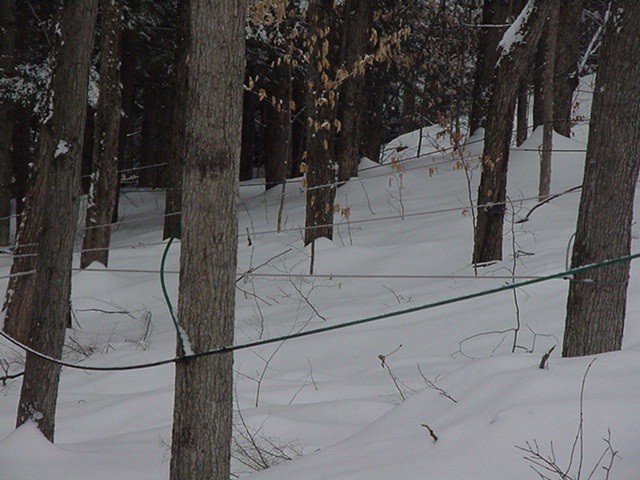Maple Sap



|
I just spent a week in Vermont. It wasn't really ski season, although there was
a lot of snow and the lifts appeared to be operational. It is mud season, and
the sap is running.
Maple syrup is to Vermont what wooden shoes are to Holland, or is that like cheese in Denmark. I mean every tourist comes back with maple syrup. It's a big deal. I went for a tour at Martins Maple Farm in Chester, which is in Southern Vermont. His backyard is full of maple trees, with over 1600 taps. A tree can have more than one tap if it is big. The taps do not kill the tree, which usually must be older then 40 years before it can be tapped at all. They all continue to survive and bloom and grow. It turns out well for everyone, since they would cut down the trees for wood otherwise. This way, they can all live for a hundred years and more. Each tap can yield 10 gallons of sap. There is a network of rubber tubing that connects all the trees with the main processing building. The sap runs in to the processing building where it is flashed, maybe by ultraviolet light to kill the germs. Then it enters a reverse osmosis machine where up to 75 percent of the water is removed. From there, it enters a vat where it is boiled. There are three consecutive boiling vats. And before you know it, you have maple syrup. It takes 40 gallons of sap to make one gallon of maple syrup. They also have maple syrup hard candy, which is further processed by heatings and coolings. While different places do slightly different things, they are all similar but for a few differences. Sometimes the hard candy may have other ingredients, but it is pure at Martins. It is pure maple syrup. However the maple syrup is not pure anywhere. Because everyone adds some fat to the boiling vats to cut down on the foaming. Otherwise, the foam can become such a problem that it would burn and become unmanageable. Tom, the owner, is happy to say that he does not use lard, but uses a kosher substitute. We watched him sprinkle a pinch of white powder into a vat and he let us read the label. I don't remember the exact chemical name, but it was a steroid. I assumed it was an extraction or refinement of beef fat. I tasted the maple syrup and then bought some for dear old Mom. But for myself, I bought the sap. I don't know how hard it is to buy the sap, but Tom was very accommodating. He collected the running sap for me into gallon bottles before it entered the building and before it was flashed. I got the pure, fresh, unprocessed running sap: only a dollar a gallon, not including the cost of the gallon containers, which I refilled before leaving the following week. I still have 4 gallons left, in my freezer. I have frozen them, because the sap doesn't last too long. It is clear and light and a variation of water, just like coconut water in a way. But after a few days it starts to thicken and becomes scary. I highly recommend the sap. If you go to Southern Vermont, stop off at Tom's and tell him JR said hi. His web address is Martin's Maple Farm . The sap only runs for a few weeks a year; sometime between February and April, usually at the end of the snow season. Look for warm days and cold nights. If you want to catch Vermont when the sap is running, i suggest you call Tom and keep in touch. It might be finished for the season any day now, so hurry if you want this year. |
info@martinsmaplefarm.com Phone: 802-875-1271 Fax: 802-875-3421 2136 Rockingham Rd. Chester, Vermont 05143 www.martinsmaplefarm.com |
 |